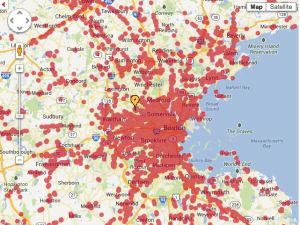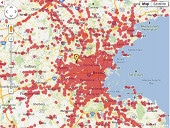One of the big challenges to the growth of the “Internet of Things” is access. It goes without saying that, without access to the Internet, almost all of the benefits of connected devices disappear. Your smart phone becomes a dumb phone. Your ‘net connected watch or running shoes or car scream into the void – trying desperately to connect to a network that isn’t there.
Here in the U.S., that problem has typically been addressed by routing traffic through 3G or – depending on where you live – 4G wireless networks. However, access to those networks is spotty, especially in the sparsely populated Western U.S. According to a survey by the U.S. Federal Communications Commission (FCC), much of the Western U.S. is a 3G wasteland, with little or no access to broadband wireless networks.
One solution is to tap the loose network of residential broadband subscribers, allowing them to peel off some unused bandwidth to serve as an impromptu wi-fi “hotspot” for the public, or neighbors and guests.
This week, Comcast took a big step down that road, announcing a new wireless gateway for customers that broadcasts two signals: one for the private use of the home subscriber, the second an open “xfinititywifi” signal that can be used by the public. Comcast promotes the new program as an “extension of the Xfinity Wifi network” that will allow Comcast subscribers to sign in and connect using their own user names and passwords.”

The reach of this is huge, as this map of xfinitywifi hotspots in the Boston area illustrates. Today, Comcast has 20 million customers nation-wide and said the residential hot spots are “part of a broader strategy to create the foundation our customers need to power their Internet-connected devices in and out of the home.”
The company started a trial neighborhood hotspot program in Pennsylvania, New Jersey, Northern Virginia and the Washington D.C. metro area last year. That currently involves around 100,000 Xfinity subscribers.
Of course, there are real and obvious privacy concerns that go along with any such program – as this article notes. Among them are privacy and security. Having a public wi-fi signal be part of every piece of Comcast wi-fi CPE (customer premises equipment) keeps customers from having to share a wi-fi password. But it also makes their home network part of Comcast’s global wi-fi infrastructure. That legitimizes “war driving” – a until recently frowned upon practice in which folks would drive around with wi-fi sniffing tools looking for open wireless routers which were then commandeered.

Now with Verizon providing maps of customers’ homes and wifi hotspots, war driving tools are now obsolete. could have unintended consequences: from unwanted strangers parked outside a home (legitimately, it would seem) to pirated or other undesirable content being downloaded through hardware located within your home.
Comcast notes that the system is secure, with no opportunity for public wifi users to infiltrate the home network. The company also says home wifi users aren’t liable for what goes on via the public wifi component of their CPE. Finally, ccustomers can always opt-out- disabling the feature that is enabled by default. We wonder if it should be the other way around.

